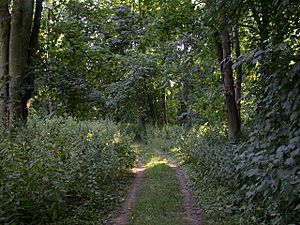Kingston Wood and Outliers facts for kids
| Site of Special Scientific Interest | |
 |
|
| Area of Search | Cambridgeshire |
|---|---|
| Interest | Biological |
| Area | 47.4 hectares |
| Notification | 1984 |
| Location map | Magic Map |
Kingston Wood and Outliers is a special place in Cambridgeshire, England. It's a large area of woodland, about 47.4 hectares (that's like 70 football fields!). This area is so important for nature that it's been named a 'Site of Special Scientific Interest' (SSSI). This means it's protected by law because of its amazing plants and wildlife.
The site is made up of several different woods. These include Kingston Wood itself, Pincote Wood, Hawk's Wood, and Lady Pastures Spinney. You can find this special woodland south-west of a village called Kingston.
Contents
What Makes Kingston Wood Special?
Kingston Wood and Outliers is known as an ancient woodland. This means it has been a woodland for hundreds of years, probably since the year 1600 or even earlier! These old woodlands are very important because they have unique plants and animals.
Trees and Plants You'll Find
The main trees you'll see here are ash and field maple. They grow in soil that has a lot of chalky clay. This type of soil helps certain plants to grow really well.
One special thing about this woodland is how it has been managed. It's one of the oldest and most complete coppiced woodlands in Cambridgeshire. Coppicing is a traditional way of managing trees. It involves cutting down trees close to the ground. This makes them grow back with many new stems. This method helps to keep the woodland healthy. It also creates different habitats for wildlife.
Rare Flowers
The ground of Kingston Wood is home to some interesting plants. You might spot dog's mercury, which is a common plant in ancient woodlands. But even more exciting is the oxlip. This is a beautiful yellow flower that is quite rare in the UK. It only grows in a few places, making Kingston Wood very special.
Visiting Kingston Wood
Kingston Wood and Outliers is a private site. This means there is no public access for visitors. It helps to protect the delicate plants and animals that live there. Even though you can't visit, it's good to know that places like this are protected. They help keep our natural world healthy and full of amazing life.

